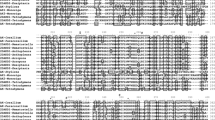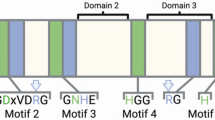Abstract
Arginine kinase (AK) is a member of a large family of phosphoryl transfer enzymes called phosphagen (guanidino) kinases. AKs are present in certain protozoans, sponges, cnidarians, and both lophotrochozoan and ecdysozoan protostomes. Another phosphagen kinase, creatine kinase (CK), is found in sponges, cnidarians, and both deuterostome and protostome groups but does not appear to be present in protozoans. To probe the early evolution of phosphagen kinases, we have amplified the cDNAs for AKs from three choanoflagellates and from the hexactinellid sponge Aphrocallistes beatrix and the demosponges Suberites fuscus and Microciona prolifera. Phylogenetic analysis using maximum likelihood of these choanoflagellate and sponge AKs with other AK sequences revealed that the AK from the choanoflagellate Monosiga brevicollis clusters with the AK from the glass sponge Aphrocallistes and is part of a larger cluster containing AKs from the demosponges Suberites and Microciona as well as basal and protostome invertebrates. In contrast, AKs from Codonosiga gracilis and Monosiga ovata form a distinct cluster apart from all other AK sequences. tBLASTn searches of the recently released M. brevicollis genome database showed that this species has three unique AK genes—one virtually identical to the M. brevicollis cDNA and the other two showing great similarity to C. gracilis and M. ovata AKs. Three distinct AK genes are likely present in choanoflagellates. Two of these AKs display extensive similarity to both CKs and an AK from sponges. Previous work has shown CK evolved from an AK-like ancestor prior to the divergence of sponges. The present results provide evidence suggesting that the initial gene duplication event(s) leading to the CK lineage may have occurred before the divergence of the choanoflagellate and animal lineages.



Similar content being viewed by others
References
Bertin M, Pomponi SM, Kokuhuta C, Iwasaki N, Suzuki T, Ellington WR (2007) Origin of the genes for the isoforms of creatine kinase. Gene 392:273–282
Borson ND, Salo W, Drewes LR (1992) A lock-docking oligo (DT) primer for 5′- and 3′-RACE PCR. PCR Meth Appl 2:144–148
Burger G, Forget L, Zhu Y, Gray MW, Lang BF (2003) Unique mitochondrial genome architecture in unicellular relatives of animals. Proc Natl Acad Sci USA 100:892–897
Campanella JJ, Bitincka L, Smalley J (2003) MatGAT: an application that generates similarity/identity matrices using protein or DNA sequences. BMC Bioinform 4:29
Ellington WR (2000) A dimeric creatine kinase from a sponge: implications in terms of phosphagen kinase evolution. Comp Biochem Physiol B 126:1–7
Ellington WR (2001) Evolution and physiological roles of phosphagen systems. Annu Rev Physiol 63:289–325
Ellington WR, Suzuki T (2006) Evolution and divergence of creatine kinase genes, In: Vial C (ed) Molecular anatomy and physiology of proteins: creatine kinase. Nova Science, New York, pp 1–27
Ellington WR, Yamashita D, Suzuki T (2004) Alternative splicing produces transcripts coding for alpha and beta chains of a hertero-dimeric phosphagen kinase. Gene 334:167–174
Frohman MA, Dus MK, Martin GR (1988) Rapid production of full length cDNAs from rare transcripts: amplification using a single gene specific primer. Proc Natl Acad Sci USA 85:8998–9002
King N (2004) The unicellular ancestry of animal development. Dev Cell 7:313–325
King N (2005) Choanoflagellates. Curr Biol 15:R113–R114
King N, Hittinger CT, Carroll SB (2003) Evolution of key cell signaling and adhesion protein families predates the origin of animals. Science 301:361–363
Kruse M, Leys SP, Müller IM, Müller WE (1998) Phylogenetic position of the Hexactinellida within the phylum Porifera based on the amino acid sequence of the protein kinase C from Rhabdocalyptus dawsoni. J Mol Evol 46:721–728
Lahiri SD, Wang PF, Babbit PC, McLeish MJ, Kenyon GL, Allen KN (2002) The 2.1 Å structure of Torpedo californica creatine kinase complexed with the ADP-Mg2+-NO– creatine transition-state analog complex. Biochem 41:13861–134867
Lang BF, Okelly C, Nerad T, Gray MW, Burger G (2002) The closest unicellular ancestors of animals. Curr Biol 12:1773–1778
Lavrov DV, Forget L, Kelly M, Lang BF (2005) Mitochondrial genomes of two demosponges provide insights into an early stage of animal evolution. Mol Biol Evol 22:1231–1239
Medina M, Collins AG, Silberman JD, Sogin ML (2001) Evaluating hypotheses of basal animal phylogeny using complete sequences of large and small subunit RNA. Proc Natl Acad Sci USA 98:9707–9712
Novak WRP, Wang P-F, McLeish MJ, Kenyon GL, Babbitt PC (2004) Isoleucine 69 and valine 325 form a specificity pocket in human muscle creatine kinase. Biochemistry 43:13766–13774
Pereira CA, Alkonso GD, Paveto MC, Iribarren A, Cabanas ML, Torres HN, Flawia MM (2000) Trypanosoma cruzi arginine kinase characterization and cloning. A novel energetic pathway in protozoan parasites. J Biol Chem 275:1495–1501
Perovic-Ottstadt S, Wiens M, Schröder HC, Batel R, Giovine M, Krasko A, Müller IM, Müller WE (2005) Arginine kinase in the demosponge Suberites domuncula: regulation of its expression and catalytic activity by silicic acid. J Exp Biol 208:637–646
Peterson FJ, McPeek MA, Evans DAD (2005) Tempo and mode of early animal evolution:inferences from rocks, Hox and molecular clocks. Paleobiology 31:36–55
Philippe H, Snell EA, Bapteste E, Lopez P, Holland PWH, Casane D (2004) Phylogenomics of eukaryotes: impact of missing data on large alignments. Mol Biol Evol 21:1740–1752
Robin Y, Guillou Y (1980) Quelque aspects du metabolisme enegrgetique les esponges. Comptes Rendus 148:121–126
Rokas A, King N, Finnerty J, Carroll SB (2003) Conflicting signals at the base of the metazoan tree. Evol Dev 5:346–359
Snell EA, Furlong RF, Holland PWH (2001) Hsp 70 sequences indicate that choanoflagellates are closely related to animals. Curr Biol 11:967–970
Sona S, Suzuki T, Ellington WR (2004) Cloning and expression of mitochondrial and protoflagellar creatine kinases from a marine sponge: implications for the origin of intracellular energy transport systems. Biochem Biophys Res Comm 317:1207–1214
Steenkamp ET, Wright J, Baldauf SL (2005) The protistan origin of animals and fungi. Mol Biol Evol 23:93–106
Strong S, Ellington WR (1996) Expression of horseshoe crab arginine kinase in Escherichia coli and site directed mutations of the reactive cysteine peptide. Comp Biochem Physiol 113B:809–816
Suzuki T, Furukohri T (1994) Evolution of phosphagen kinase. Primary structure of glycocyamine kinase and arginine kinase from invertebrates. J Mol Biol 237:353–357
Suzuki T, Kawasaki Y, Furukohri T, Ellington WR (1997) Evolution of phosphagen kinase. VI. Isolation, characterization and cDNA-derived amino acid sequence of lombricine kinase from the earthworm Eisenia foetida, and identification of a possible candidate for the guanidine substrate recognition site. Biochim Biophys Acta 1343:152–159
Suzuki T, Mizuta C, Uda K, Ishida K, Sona S, Compaan DM, Ellington WR (2004) Evolution and divergence of the genes for cytoplasmic, mitochondrial and flagellar creatine kinases. J Mol Evol 59:218–226
Uda K, Saishoji N, Ichinari S, Ellington WR, Suzuki T (2005) Origin and properties of cytoplasmic and mitochondrial isoforms of taurocyamine kinase. FEBS J 272:3521–3530
Uda K, Fujimoto N, Akiyama Y, Mizuta K, Tanaka K, Ellington WR, Suzuki T (2006) Evolution of the arginine kinase gene family. Comp Biochem Physiol D 1:209–218
Watts DC (1975) Evolution of phosphagen kinases in the chordate line. Symp Zool Soc London 36:105–127
Yousef MS, Clark SA, Pruett PK, Somasundaram T, Ellington WR, Chapman MS (2003) Induced fit in guanidino kinases—comparison of substrate-free and transition state analog structures of arginine kinase. Prot Sci 12:103–111
Zhou G, Somasundaram T, Blanc E, Parthsarathy G, Ellington WR, Chapman MS (1998) Transition state structure of arginine kinase:implications for catalysis of bimolecular reactions. Proc Natl Acad Sci USA 95:8449–8454
Acknowledgments
This research was supported by National Science Foundation Grants IOB-0130024 and IOB-0542236 to W.R.E. We thank Steve Thompson of the School of Computational Science at Florida State University for assistance with the phylogenetic analyses. We thank Dr. Nicole King, University of California at Berkeley, for providing unpublished EST data as well as for giving advice on choanoflagellate culture procedures.
Author information
Authors and Affiliations
Corresponding author
Rights and permissions
About this article
Cite this article
Conejo, M., Bertin, M., Pomponi, S.A. et al. The Early Evolution of the Phosphagen Kinases—Insights from Choanoflagellate and Poriferan Arginine Kinases. J Mol Evol 66, 11–20 (2008). https://doi.org/10.1007/s00239-007-9058-0
Received:
Revised:
Accepted:
Published:
Issue Date:
DOI: https://doi.org/10.1007/s00239-007-9058-0




